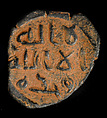Returned to lender The Met accepts temporary loans of art both for short-term exhibitions and for long-term display in its galleries.
Anonymous Aniconic Fals
Not on view
The Byzantine Empire issued the gold solidus, or nomisma, used primarily for large transactions such as tax payments, and several denominations of copper coins, the money of daily business transactions. Mints in Antioch and Alexandria supplied the majority of the coinage circulated in the southern provinces. The newly established Arab government inherited an efficient monetary system and made few changes during its first decades. The caliph ‘Abd al-Malik (r. 685–705) introduced several issues of distinctively Islamic coinage.
In 696/97 ‘Abd al-Malik (r. 685–705) began issuing a series of coins bearing only religious inscriptions in Arabic. Such epigraphic coins are one of the many reforms introduced during his caliphate that laid the foundations for the imagery of the Islamic state.
Copper coins with figural imagery were produced regularly alongside aniconic examples until 713/14 and intermittently as late as 754/55. This example is inscribed in Arabic,"There is no god but God alone" (obverse) and "Muhammad is the prophet of God" (reverse).
Due to rights restrictions, this image cannot be enlarged, viewed at full screen, or downloaded.
This artwork is meant to be viewed from right to left. Scroll left to view more.



